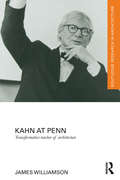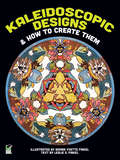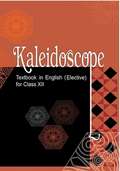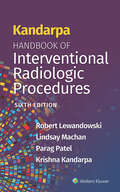- Table View
- List View
Kagan Cooperative Learning
by Miguel KaganThis new book presents today's most successful cooperative learning methods. The Kagans make it easier than ever to boost engagement and achievement. You'll still find all the practical and proven Kagan Structures, including Numbered Heads Together, RoundTable, and Three-Step Interview—direct from the man who invented cooperative learning structures. And there's still plenty of ready-to-do teambuilding and classbuilding activities to make your class click. But in this expanded edition, you will find new step-by-step structures, hundreds of helpful management tips, many more teacher-friendly activities and forms, and up-to-date research on proven methods. You hear how schools have used Kagan Cooperative Learning to boost academics, close the achievement gap, improve student relations, and create a more kind and caring school community. After decades of training and working with hundreds of thousands of teachers, Kagan has refined and perfected the most widely used and respected form of cooperative learning ever. The Kagans make it easy for you to dramatically increase engagement and achievement in your class!.
Kahn at Penn: Transformative Teacher of Architecture (Routledge Research in Architecture)
by James WilliamsonLouis I. Kahn is widely known as an architect of powerful buildings. But although much has been said about his buildings, almost nothing has been written about Kahn as an unconventional teacher and philosopher whose influence on his students was far-reaching. Teaching was vitally important for Kahn, and through his Master’s Class at the University of Pennsylvania, he exerted a significant effect on the future course of architectural practice and education. This book is a critical, in-depth study of Kahn’s philosophy of education and his unique pedagogy. It is the first extensive and comprehensive investigation of the Kahn Master’s Class as seen through the eyes of his graduate students at Penn.
Kalarav class 1 - GSTB: કલરવ ધોરણ 1 (પાઠ્યપુસ્તક ) - જીએસટીબી
by Prakash Bhatti Shri Ramesh Chandra Thakkar Shri Goswami Minesh Varand Harshvi Patપ્રસ્તુત પાઠ્યપુસ્તક તેનાં ચતુરંગી સ્વરૂપ દ્વારા બાળકો હોંશે-હોંશે તેનો ઉપયોગ કરે અને ભાષા-પર્યાવરણની અધ્યયન નિષ્પત્તિઓ સાર્થક કરે તે લક્ષિત છે. પ્રસ્તુત પાઠ્યપુસ્તક ધોરણ ૧ ના ગુજરાતી (કલરવ)વિષય નું છે. જેમાં રોચક ૧૦ પાઠ આપેલ છે.
Kaleidoscopic Designs and How to Create Them
by Norma Y. FinkelKaleidoscopic designs are thrilling in their profusion of color and repeating patterns, but they look so complex that creating one would seem to be virtually impossible. Norma and Leslie Finkel have done the impossible. They have discovered a simple way to create unlimited numbers of kaleidoscopic designs (in 4, 6, or 8 segments). Best of all, you don't have to be an artist to do it, since any printed illustration can be used as the basis of a design. All you need are tracing paper, carbon paper, and a few other inexpensive items. The Finkels give step-by-step instructions for creating handsome circular designs; they also offer 37 plates showing completed designs based on such themes as nature, animals, sports, and abstract arrangements. Four of these designs are shown in color on the covers.
Kaliedoscope English (Elective) class 12 - NCERT
by National Council of Educational Research and TrainingThis book prescribed by central board of secondary education, India for the students of class 12th subject English. This accessible version of the book doesn't leave any part of the book. The book is handy companion of the school going students.
Kallol (Gujarati Paryavaran) class 2 - GSTB: કલ્લોલ (ગુજરાતી પર્યાવરણ ) ધોરણ ૨ - જીએસટીબી
by Bhavesh Pandya Shri Patel Haresh Chowdhury Yahya Sapatwala Shri Buddhadev Shri Dalsania Harshvi Patelધોરણ ૨ નું કલ્લોલ ગુજરાતી પર્યાવરણનું પાઠયપુસ્તક છે. જેમાં ૧૦ પાઠ આપેલ છે.
Kalpanalokaya - කල්පනා ලෝකය
by Ediriweera Sarachchandra - එදිරිවීර සරච්චන්ද්රකවියා හෝ චිත්රකරුවා හෝ මූර්ති ශිල්පියා මවන ලෝකය අභව්ය ලෝක නොව, "විය හැකි ලෝකය" ය. කරුණු මෙසේ හෙයින් The Imaginary World යන අර්ථයෙන් වෙනත් සාහිත්ය කල්පනා ලෝකයක් සේ සැළකිය හැකි බව පෙනේ.
Kalshor class 3 - GSTB: કલશોર ધોરણ 3 - જીએસટીબી
by Shree Haresh Choudhari Shree Rakesh Patel Shree Chhaya Upadhyay Shree Ranchhodbhai Soni Shree Mamta Sharma Shree Enduben Patel Shree Priskiya Chauhanધોરણ ૩ નું કલશોર (પ્રથમ ભાષા) નું પાઠચપુસ્તક છે તેમાં 10 પાઠ આપેલ છે.
Kanakku (Maths) 10th Standard - Tamilnadu Board
by Training State Council of Educational ResearchKanakku (Maths) Textbook for the 10th Standard Students, preparing for Tamil Nadu State Board Exam.
Kanakku Pathiviyal (Accountancy) 11th Standard - Tamilnadu Board
by Training State Council of Educational ResearchKanakku Pathiviyal (Accountancy) Textbook for the 11th Standard Students, preparing for Tamil Nadu State Board Exam.
Kanakku Pathiviyal (Accountancy) Thoguthi - I 12th Standard - Tamilnadu Board
by Training State Council of Educational ResearchKanakku Pathiviyal (Accountancy) Textbook Thoguthi- 1 for the 12th Standard Students, preparing for Tamil Nadu State Board Exam.
Kanakku Pathiviyal (Accountancy) Thoguthi - II 12th Standard - Tamilnadu Board
by Training State Council of Educational ResearchKanakku Pathiviyal (Accountancy) Textbook Thoguthi- II for the 12th Standard Students, preparing for Tamil Nadu State Board Exam.
Kandarpa Handbook of Interventional Radiologic Procedures
by Robert Lewandowski Lindsay Machan Parag J. Patel Krishna KandarpaFocusing on time-tested protocols, tailored imaging and current procedural equipment, this popular, practical handbook by Drs. Krishna Kandarpa, Lindsay Machan, Robert Lewandowski, and Parag J. Patel features extensive updates to keep you current with rapid growth in the field. Now in brilliant full color throughout, Kandarpa Handbook of Interventional Radiologic Procedures, 6th Edition, is a convenient, easy-access guide to all current radiologic procedures. It’s an ideal resource not only for practicing interventional and general radiologists, but also for fellows and residents in training, IR nurses, and special procedure technologists.
Kanini Ariviyal (Computer Science) Thoguthi 1 class 11 - Tamil Nadu Board: கனினி அரிவியல் (கணினி அறிவியல்) தோகுதி 1 வகுப்பு 11 - தமிழ்நாடு வாரியம்
by Government Of TamilnaduThis book helps the readers to understand the importance of computer in the 21st century and it is designed in a way to Annalise the each concept in depth.
Kanippori Iyal (Computer Science) Thoguthi- 1 Karuvikal (Tools) 12th Standard - Tamilnadu Board
by Training State Council of Educational ResearchKanippori Iyal (Computer Science) Textbook Thoguthi- 1 Karuvikal (Tools) for the 12th Standard Students, preparing for Tamil Nadu State Board Exam.
Kanippori Iyal (Computer Science) Thoguthi- 2 Porul Nokku Thozhil Nutpam (Objects Technology) 12th Standard - Tamilnadu Board
by Training State Council of Educational ResearchKanippori Iyal (Computer Science) Textbook Thoguthi- 2 Porul Nokku Thozhil Nutpam (Objects Technology) for the 12th Standard Students, preparing for Tamil Nadu State Board Exam.
Kanippori Iyal Thoguthi - I Karuththukkal (Concepts) 11th Standard - Tamilnadu Board
by Training State Council of Educational ResearchKanippori Iyal Textbook Thoguthi - I Karuththukkal (Concepts) for the 11th Standard Students, preparing for Tamil Nadu State Board Exam.
Kanippori Iyal Thoguthi -II Seimurai (Practice) 11th Standard - Tamilnadu Board
by Training State Council of Educational ResearchKanippori Iyal Textbook Thoguthi -II Seimurai (Practice) for the 11th Standard Students, preparing for Tamil Nadu State Board Exam.
Kannada Bhaasha Patya Pustaka- Kalaa Kannada- 4 (NEP Syllabus) - Bangalore University: ಕನ್ನಡ ಭಾಷಾ ಪಠ್ಯಪುಸ್ತಕ – ಕಲಾ ಕನ್ನಡ – 4 (NEP ಪಠ್ಯಕ್ರಮ)
by Bangalore Universityಇದು ಬೆಂಗಳೂರು ವಿಶ್ವವಿದ್ಯಾಲಯಗಳ ಎನ್ಇಪಿ ಪಠ್ಯಕ್ರಮದಡಿಯಲ್ಲಿ ಕನ್ನಡ ಮಾಧ್ಯಮದ ಬಿ.ಎ 4ನೇ ಸೆಮಿಸ್ಟರ್ ವಿದ್ಯಾರ್ಥಿಗಳಿಗಾಗಿ ಶೈಕ್ಷಣಿಕ ಪಠ್ಯಪುಸ್ತಕವಾಗಿದೆ.
Kannada Bhasha Patya 1st Semester B.COM: ಕನ್ನಡ ಭಾಷಾ ಪಠ್ಯ ಪ್ರಥಮ ಸೆಮಿಸ್ಟರ್ ಬಿ.ಕಾಂ
by Bangalore Universityಇದು ಕನ್ನಡ ಭಾಷಾ ಪಠ್ಯ ಐಚ್ಚಿಕ ಕನ್ನಡ ಪ್ರಥಮ ಸೆಮಿಸ್ಟರ್ ಬಿ.ಕಾಂ ಶಿಕ್ಷಣದ ಪಠ್ಯಕ್ರಮದಂತೆ ಕನ್ನಡ ಮಾಧ್ಯಮ ವಿದ್ಯಾರ್ಥಿಗಳಿಗೆ ಈ ಪಠ್ಯ ಪುಸ್ತಕವು ಉಪಯುಕ್ತವಾಗಿದೆ.
Kannada Language 1 class 6 - Karnataka Board: ಕನ್ನಡ ಭಾಷೆ 1 ನೇ ತರಗತಿ 6 - ಕರ್ನಾಟಕ ಮಂಡಳಿ
by Karnataka Patyapusthaka SanghaKannada Language-1 textbook for 6th Standard Kannada medium, Karnataka State.
Kannada Language 1 class 7 - Karnataka board: ಕನ್ನಡ ಭಾಷೆ 1 ನೇ ತರಗತಿ 7 - ಕರ್ನಾಟಕ ಮಂಡಳಿ
by Karnataka Patyapusthaka SanghaKannada Language-1 Textbook for 7th Standard Kannada medium, Karnataka State
Kannada Language 1 class 9 - Karnataka Board: ಕನ್ನಡ ಭಾಷೆ 1 ನೇ ತರಗತಿ 9 - ಕರ್ನಾಟಕ ಮಂಡಳಿ
by Karnataka Patyapusthaka SanghaKannada Language-1 Textbook for 9th Kannada medium Karnataka State
Kannada Surabhi Vikram Digest: ಕನ್ನಡ ಸುರಭಿ ವಿಕ್ರಂ ಡೈಜಿಸ್ಟ್
by Vikram Prakashanaಇದು ದಾವಣಗೆರೆ ವಿಶ್ವವಿದ್ಯಾನಿಲಯದಿಂದ ಪದವಿ ಕೋರ್ಸ್ಗಳಿಗೆ ಆಯ್ಕೆ ಆಧಾರಿತ ಕ್ರೆಡಿಟ್ ವ್ಯವಸ್ಥೆ (CBCS) ಯೋಜನೆ ನಾಲ್ಕನೇ ಸೆಮಿಸ್ಟರ್ಗಾಗಿ ಕನ್ನಡ ಡಿಜಿಸ್ಟ್ ವಿದ್ಯಾರ್ಥಿಗಳಿಗೆ ಈ ಪಠ್ಯ ಪುಸ್ತಕವು ಉಪಯುಕ್ತವಾಗಿದೆ.





